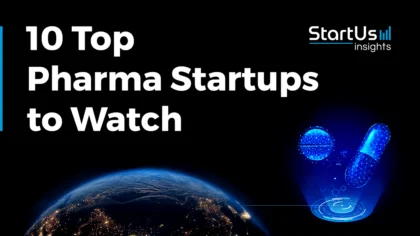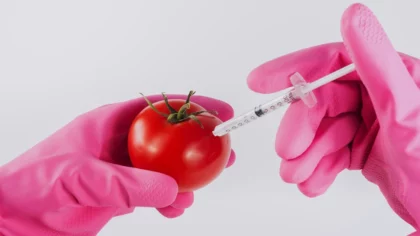Accelerate Productivity in 2025
Reignite Growth Despite the Global Slowdown
Executive Summary: What are the Top 10 Pharmaceutical Manufacturing Trends in 2026 & Beyond?
- AI-enabled Manufacturing: Market will grow from USD 0.88 billion this year to USD 34.8 billion by 2040 at a compound annual growth rate (CAGR) of 27.8%. Machine learning (ML) held 38.78% of the market share in 2024, while generative AI adoption is expected to rise at a 43.12% CAGR.
- Biomanufacturing: Continuous bioprocessing lowers production costs by up to 75% while achieving titers of 4 g/L/day. Markets for bioprocess optimization and digital biomanufacturing are projected to reach USD 39.6 billion by 2029.
- Advanced Therapy Modalities: Between 2019 and 2021, new modalities expanded at a 28% CAGR, driven by monoclonal antibody (mAbs), antibody-drug conjugate (ADCs), recombinant proteins, and more. By 2024, they accounted for 55-57% of pipeline value and reached USD 168 billion.
- Personalized & Precision Medicine: Personalized medicine accounted for 38% of approved new molecular entities in 2024. High-mix, low-volume production environments drive adoption of continuous bioprocessing, modular systems, and closed-cell and gene therapy platforms.
- Green Chemistry Practices: Continuous and single-use manufacturing reduces energy use 4.5x and waste by up to 19%, while solvents still account for nearly 50% of API inputs. Growth in enzyme discovery, biocatalysis, and flow-photochemistry drives greener routes.
- Anti-Counterfeit & Supply Chain Security: The pharma serialization and traceability market will reach USD 28.6 billion by 2032 at a 15.9% CAGR. Protected QR codes with encrypted data prevent tampering without major infrastructure changes, while blockchain reduces counterfeit incidence by up to 90%.
- Continuous Manufacturing: The market is expected to reach USD 4.91 billion by 2032 at a CAGR of 14.1%. Integrated systems made up 36.4% of the market in 2024, while solid dosage products accounted for 41.1%.
- Enhanced Quality Control: This market is projected to grow from USD 14.43 billion in 2025 to USD 40.16 billion by 2034 at a CAGR of 12.06%. Parallel growth in the analytical testing segment to reach USD 16.65 billion by 2032 – driven by AI, machine vision, robotics, and process analytical technology (PAT) tools.
- Contract Development and Manufacturing Organizations (CDMOs) Expansion: The CDMO market is expected to expand from USD 197.4 billion in 2025 to USD 368.7 billion by 2034 at a 7.2% CAGR. Growth is increased by the outsourcing of complex biologics and advanced modalities, with strong demand in oncology and cell and gene therapies.
- On-Demand & Flexible Manufacturing: Flexible systems are projected to reach USD 2.3 billion in market size by 2026. This will be driven by plug-and-produce platforms, microfactories, and modular facilities. They enable smaller batch sizes, distributed production, and faster adaptation to therapies.
Read on to explore each trend in depth – uncover key drivers, current market stats, cutting-edge innovations, and 20 leading innovators shaping the future.
Frequently Asked Questions
1. What is pharma 4.0?
Pharma 4.0 refers to the adoption of Industry 4.0 or smart manufacturing solutions, like AI, ML, Internet of Things (IoT), robotics, and big data, in pharmaceuticals. It enables intelligent, interconnected, and data-driven manufacturing across the entire product life cycle.
2. What are the issues faced by the pharmaceutical manufacturing industry?
The pharmaceutical manufacturing industry faces regulatory complexity, frequent quality control failures, talent and technology adoption gaps, and vulnerable supply chains. They lead to recalls, higher costs, and drug shortages.
Methodology: How We Created the Pharma Manufacturing Trend Report
For our trend reports, we leverage our proprietary StartUs Insights Discovery Platform, covering 7M+ global startups, 20K technologies & trends, plus 150M+ patents, news articles, and market reports.
Creating a report involves approximately 40 hours of analysis. We evaluate our own startup data and complement these insights with external research, including industry reports, news articles, and market analyses. This process enables us to identify the most impactful and innovative trends in the pharma manufacturing industry.
For each trend, we select two exemplary startups that meet the following criteria:
- Relevance: Their product, technology, or solution aligns with the trend.
- Founding Year: Established between 2020 and 2025.
- Company Size: A maximum of 200 employees.
- Location: Specific geographic considerations.
This approach ensures our reports provide reliable, actionable insights into the pharmaceutical manufacturing innovation ecosystem while highlighting startups driving technological advancements in the industry.
Innovation Map outlines the Top 10 Pharmaceutical Manufacturing Industry Trends & 20 Promising Startups
For this in-depth research on the Top Pharma Manufacturing Trends & Startups, we analyzed a sample of 1474 global startups & scaleups. The Pharmaceutical Manufacturing Innovation Map created from this data-driven research helps you improve strategic decision-making by giving you a comprehensive overview of the pharma industry trends & startups that impact your company.
Tree Map reveals the Impact of the Top 10 Pharma Manufacturing Trends in 2026
Based on the Pharma Manufacturing Innovation Map, the Tree Map below illustrates the Top 10 Trends. AI-enabled manufacturing integrates machine learning, computer vision, and generative AI for smart production.
Biomanufacturing evolves through continuous processes, modular facilities, and digital optimization to reduce costs. Advanced therapy modalities also expand with ADCs, gene therapies, and automation-driven scalability.
Personalized medicine drives adaptive small-batch production with 3D printing, microfluidics, and closed systems, while green chemistry emphasizes biocatalysis, solvent reduction, and continuous flow.
Anti-counterfeit and supply chain security adopt serialization, RFID, blockchain, and zero-trust cybersecurity. Continuous manufacturing grows under the FDA’s FRAME initiative with end-to-end (E2E) and modular platforms.
CDMOs also expand biologics, ADCs, and cell and gene therapy capacity with green and digital tools. Further, on-demand and flexible manufacturing leverages modular microfactories, photochemistry, and pathogen inactivation to adapt quickly.
Global Startup Heat Map covers 1474 Pharma Manufacturing Startups & Scaleups
The Global Startup Heat Map showcases the distribution of 1474 exemplary startups and scaleups analyzed using the StartUs Insights Discovery Platform. It highlights high startup activity in India and the US, followed by the UK. From these, 20 promising startups are featured below, selected based on factors like founding year, location, and funding.
Want to Explore Pharma Manufacturing Innovations & Trends?
Top 10 Emerging Pharmaceutical Manufacturing Trends [2026 and Beyond]
1. AI-enabled Manufacturing: A USD 34.8B Market by 2040
ML algorithms dominated the technology segment, accounting for 38.78% of the AI pharmaceutical market share in 2024. Computer vision technology assists in automated quality control.
Likewise, generative AI is expected to grow at a 43.12% CAGR while using latent-space manipulation to design new molecules that meet specific bioactivity requirements.
Credit: Roots Analysis
Accordingly, the AI market in drug manufacturing is projected to grow from USD 0.88 billion in 2025 to USD 34.8 billion by 2040 at a CAGR of 27.8%.
AI applications also include predictive maintenance and process control solutions that reduce downtime and prevent costly failures.
For example, Novartis uses AI-driven analytics on sensor and equipment data to predict failures in production lines. This minimizes unplanned shutdowns and safeguards batch quality.
While investing to accelerate AI-enabled manufacturing, GSK also invested up to USD 800 million to expand its Marietta, Pennsylvania site. The upgrade includes digital twins, robotics, predictive maintenance, and smart process optimization.
Further, Pfizer expanded its collaboration with PostEra to USD 610 million, launching a new antibody-drug conjugate (ADC) program using PostEra’s Proton AI platform to optimize payload properties.
Future advances include quantum-AI hybrid models for improved in-silico predictions and digital twins evolving into 4-P models covering processes, facilities, products, and patient replicas.
Pando Bioscience offers Gen AI-designed Enzymes
US-based startup Pando Bioscience makes AI-designed enzymes for pharmaceutical manufacturing and diagnostics. Its protein-specific AI models design new enzymes or improve existing ones by introducing targeted mutations that optimize multiple properties simultaneously.
The startup integrates these designs with an ultra-high-throughput one-pot screening platform that generates large, high-quality datasets under diverse conditions. These are then fed back into the AI for continuous learning.
It reduces the design-build-test-learn cycle and achieves higher hit rates compared to models trained solely on public databases.
Phorum AI improves Therapeutics Purification
US-based startup Phorum AI develops AI-driven solutions for drug manufacturing that optimize processes across multiple therapeutic modalities. It includes small molecules, peptides, mRNA, small interfering ribonucleic acid (siRNA), adeno-associated viruses (AAVs), and cell and gene therapies.
The startup’s proprietary molecular AI model, PHORUM-GPT, uses real-world chemical reaction data and in vitro experiments. It predicts synthesis risks, recommends purification strategies, improves formulations, and enhances production processes.
The solution integrates into the drug development lifecycle from early candidate selection to quality assurance, and addresses inefficiencies that increase cost, time, and environmental waste.
By improving purification efficiency and enhancing yield, quality, and regulatory compliance, the startup enables scalable, cost-effective biomanufacturing while expanding patient access to critical therapeutics.
2. Biomanufacturing: Continuous Biomanufacturing Lowers 30% Costs
Continuous biomanufacturing enables uninterrupted production, where fresh cell culture media are constantly supplied and the product is steadily harvested without stopping the process. This lowers production costs by 30%, improves product consistency, and increases process control.
Moreover, companies recorded that continuous bioprocessing achieves titers of 4 g/L/day or more and reduces monoclonal antibody production costs by up to 75% for commercial products.
At the same time, modular biomanufacturing platforms reshape facility design by using prefabricated cleanroom systems and placing technical equipment outside the cleanroom.
Platforms like KeyPlants’ Modular Bio Solutions handle multiple processes like mRNA, therapeutic proteins, monoclonal antibodies, cell therapies, and viral vectors.
Meanwhile, the bioprocess optimization and digital biomanufacturing market is expected to reach USD 39.6 billion by 2029. It focuses on enhancing upstream processes like cell culture and fermentation, as well as downstream processes such as purification and filtration.
Additionally, AI integration in biopharma manufacturing improves clinical trial design, precision medicine, and real-time monitoring of bioreactors to detect issues before they affect production.
In biopharmaceutical manufacturing, these tools enable real-time tracking of critical quality attributes in cell culture and fermentation, optimize yields by predicting nutrient demands or oxygen uptake, and reduce batch failures.
Further, the cell and gene therapy biomanufacturing market is supported by innovations in automated cell processing, viral vector production, and CAR-T manufacturing.
However, CAR-T therapy production remains complex, with costs often exceeding USD 300K per patient due to individualized processes. Automated solutions address these challenges, with semi-automated systems enabling cell selection, stimulation, transduction, and expansion in closed environments.
With this, China is becoming a major growth hub of biomanufacturing, with USD 4.17 billion invested in 2024 and expansion plans under the Biotech 2030 framework. It prioritizes biomanufacturing with tax incentives, land access, and funding support for CDMOs.
Space LiinTech makes Space Medicine in Microgravity
South Korean startup Space LiinTech develops the BEE-PC1 module, a fully automated system that conducts protein crystallization experiments in microgravity.
The module launches to the International Space Station as part of NASA’s CRS-33 mission and operates independently for four months to eliminate astronaut involvement and ensure reproducible conditions.
The system generates high-quality protein crystals that are difficult to achieve on Earth. Also, BEE-PC1 provides critical insights into protein folding, stability, and intermolecular interactions.
These structural data support the design of more stable biologics, improve formulation strategies, and reduce variability in large-scale production of complex therapeutics.
For drug developers and manufacturers, the system offers a way to derisk upstream development, optimize yields, and accelerate production of advanced therapies for previously intractable diseases.
Kolibri builds an Acoustic Transfection Unit
French startup Kolibri offers an acoustophoresis-based technology to advance cell and gene therapy manufacturing. Its system utilizes acoustic waves to manipulate mammalian cells in liquid media without physical contact, and enables real-time control of cell density and positioning.
By applying this method to HEK293 adherent and suspension cell lines, the startup demonstrates improved transfection efficiency and higher viral titers for adeno-associated virus production compared to standard methods.
It reduces manufacturing stress on cells while preserving viability and scalability. This lowers costs and addresses critical biomanufacturing bottlenecks in the production of advanced therapies.
3. Advanced Therapy Modalities: New Drug Modalities Market Reached USD 168B by 2024
Some of the advanced therapy modalities include fusion proteins, monoclonal antibodies (mAbs), gene therapies, and ADCs.
Credit: Boston Consulting Group
Between 2019 and 2021, new drug modalities grew at a 28% CAGR, led by mAbs, ADCs, recombinant proteins, BsAbs, and mRNA drugs. By 2024, they stabilized at 55-57% of pipeline value and reached USD 168 billion.
Among these modalities, ADCs see a strong momentum. Advances in antibody engineering, linker chemistries, and cytotoxic payload optimization extend ADC applications beyond oncology to dermatology, immunology, and gastrointestinal disorders. The ADC manufacturing market itself is projected to grow from USD 2.08 billion in 2025 to USD 5.02 billion by 2032.
Gene therapy manufacturing is expanding quickly, with companies investing in infrastructure development and novel technologies.
For instance, AGC Biologics’ launch of its cell & gene technologies division supports growing clinical and commercial production needs. It offers solutions like advanced viral vector platforms, automation-driven cell therapy manufacturing, and expanded global capabilities for scalable, cost-effective production.
However, manufacturing cell and gene therapies remains challenging due to process complexity, small batch sizes, and the high degree of personalization required.
To overcome these hurdles, companies are investing in automation, real-time analytics, and modular manufacturing systems. They improve scalability, ensure quality consistency, and streamline production timelines.
PNAS Therapeutics builds a Drug Delivery System
UK-based startup PNAS Therapeutics makes a one-step drug delivery system (DDS) with its Encapsula platform. It simplifies complex drug manufacturing processes through simultaneous self-assembly of active pharmaceutical ingredients with specialized polymers.
The technology forms a porous polymer matrix that encapsulates and stabilizes drugs, and enables controlled and sustained release at targeted sites.
Further, the platform reduces production steps, enhances drug efficacy, and improves safety and convenience. Its adaptability supports multiple therapeutic areas, from oncology and neurology to dermatology and immunology.
BioClonal enhances Rational Antibody Discovery
Spanish startup BioClonal develops RedMabs, an in vivo antibody discovery platform that streamlines the manufacturing pipeline for monoclonal antibodies. It enables efficient generation of candidates against challenging targets.
The platform combines optimized immunogen design, tailored immunization protocols, and proprietary adjuvants to expand antigen-specific B-cell responses. This process produces antibody sequences that traditional methods fail to capture.
It unlocks access to antibodies against G-protein-coupled receptors (GPCRs), transmembrane proteins, low immunogenic proteins, and highly homologous sequences.
This way, the technology reduces early-stage bottlenecks that often limit manufacturability. It enhances the pool of viable antibody leads, supports scalable biologics production, and improves downstream efficiency.
4. Personalized & Precision Medicine: 38% of New Molecular Entities
Personalized and precision medicine drive a shift toward data-driven, biomarker-guided, and patient-specific production models. This shift introduces high-mix, low-volume production environments that require adaptive bioprocessing, digital twins, and AI-integrated quality control.
In 2024, personalized medicine accounted for 38% of approved new molecular entities.
Manufacturers invest in continuous bioprocessing and closed-system cell and gene therapy platforms to improve efficiency and scalability. They also adopt on-demand modular facilities capable of producing specialized biologics, mRNA-based therapies, and antibody-drug conjugates quickly.
Additionally, real-time patient data from clinical pipelines, electronic health records (EHRs), and companion diagnostics feeds back into manufacturing ecosystems. This feedback loop enables dynamic process optimization by continuously monitoring and refining production parameters.
Credit: Pancreatic Cancer Action Network
Factors like dosage strength, formulation stability, and delivery mechanisms are adjusted to meet the needs of specific patient populations rather than generalized markets.
For example, one study showed that targeted therapies extended the life expectancy of pancreatic cancer patients by an average of one year.
Emerging methods like 3D printing, microfluidics, continuous manufacturing, and pharmacy-on-demand systems enable highly customized drug production. These innovations allow manufacturers to achieve precise dosing accuracy and create flexible release profiles.
Tools like AI, IoT, and digital twins are embedded across production workflows for real-time monitoring, dynamic batch configuration, and adaptive quality control that supports precision therapies.
In parallel, biopharma companies are expanding their manufacturing capabilities for personalized and precision medicines.
For instance, Roche committed USD 50 billion to enhance its US operations, including a gene therapy and obesity drug facility. Similarly, AstraZeneca plans to invest USD 50 billion by 2030 in cell therapy and R&D facilities.
These developments highlight how flexible production systems have become critical to meeting patient-specific needs to ensure faster batch turnaround times. Modular manufacturing platforms further enhance these systems by tailoring production processes to therapy modalities.
Ascinta Technologies provides AI-powered Theranostic Imaging
Canadian startup Ascinta Technologies offers a quantitative nuclear imaging software and theranostics platform for tailored radiopharmaceutical therapies.
The startup integrates positron emission tomography (PET) and single photon emission computed tomography (SPECT) image reconstruction with corrections for partial volume, scatter, and attenuation. It delivers precise organ- and lesion-level analysis.
Further, the platform advances clinical trial workflows by designing imaging protocols, harmonization methods, and kinetic modeling strategies that ensure reproducible and standardized quantification across theranostic studies.
Additionally, Ascinta Technologies builds scalable, web-based applications for image processing and predictive modeling by incorporating AI to optimize radiopharmaceutical dosimetry and therapeutic planning.
ChomiX Biotech offers Chemoproteomic Technologies
Chinese startup ChomiX Biotech develops chemical proteomics platforms that investigate drug-protein interactions in living cells to support pharmaceutical manufacturing and drug discovery.
The startup’s ChomiXScreen platform applies data-independent acquisition-activity-based protein profiling (DIA-ABPP) to screen covalent lead compounds. It treats cells with candidate molecules to enrich probe-labeled peptides, and analyzes binding networks through high-resolution mass spectrometry.
This enables precise evaluation of binding ability and selectivity at specific amino acid residue pockets while reducing false positives that arise under high-concentration conditions.
In parallel, the ChomiXTarget platform identifies on-target and off-target effects of active molecules, clarifies mechanisms of action, and provides insights into drug pathways and potential side effects. It also integrates covalent and non-covalent ligand profiling, binding site identification, and quantitative occupancy analysis.
This way, the startup delivers data that improves the efficiency, accuracy, and success rate of small molecule drug development and strengthens manufacturing pipelines for targeted therapies.
5. Green Chemistry Practices: Pfizer Reduced Waste by 19%
Companies are shifting toward continuous and single-use manufacturing platforms to reduce energy and water usage while improving efficiency.
Merck reported a 4.5x reduction in energy consumption and notable reductions in water use and CO2 emissions after deploying a continuous, single-use process. Similarly, Pfizer achieved 19% less waste and 56% productivity gains by embedding greener process changes.
With advances in enzyme discovery, engineering, and cascade reactions, biocatalysis supports late-stage functionalizations and chiral building block synthesis.
Another key trend is solvent minimization and substitution. Solvents contribute up to 50% of total material usage in active pharmaceutical ingredient (API) manufacturing.
Companies like GSK, Pfizer, and Sanofi, along with the ACS Green Chemistry Institute Pharmaceutical Roundtable (ACS GCIPR), developed solvent selection guides to reduce environmental impact.
Additionally, advances in PAT and real-time release testing (RTRT) drive greener practices. They enable real-time monitoring, reduce reprocessing, and minimize out-of-specification investigations.
ICH Q14 2023 guidelines also accelerated the use of data-driven methods in both batch and continuous manufacturing.
Recent developments include flow-photochemistry platforms and reductions in solvent use, energy consumption, and cycle times.
Similarly, the expansion of enzyme toolkits, including Candida antarctica lipase B (CALB)-like mini biocatalysis reactors, enables faster route scouting and greener approaches for chiral API production.
At the same time, the industry is witnessing increased patent activity around sustainable technologies. Notably, filings like EP4326725A1 (2024) propose bio-based solvents designed as safer drop-in replacements.
ExCulture builds a Fermentation Bioprocess Technology
Dutch startup ExCulture develops an animal-free bioprocessing technology that replaces conventional inputs with controlled, patented innovations. It utilizes low-cost, readily available feedstocks and standardized processes to generate uniform product batches with high purity.
By eliminating reliance on animal-derived materials and reducing production costs, the startup provides a sustainable alternative. It supports reliable supply chains and accelerates broader adoption of next-generation bioprocessing solutions.
CataLum Technologies provides Adaptive Photocatalysis
Canadian startup CataLum Technologies offers gallium nitride-based photocatalysis to enable green chemical reactions that operate at ambient pressures and temperatures using light as the primary energy source.
The material is tuned by combining with other semiconductors or by decorating with metals. This adaptability supports the sustainable production of industrial and specialty chemicals, high-density fuels from waste streams, and pharmaceutical manufacturing precursors.
6. Anti-Counterfeit Technologies & Supply Chain Security: 90% Counterfeit Reduction with Blockchain
Michigan State University’s Axia Institute conducted RFID traceability as a complement to barcodes and achieved 100% traceability across nearly 7000 products. It aligns with Global Standards 1 (GS1) and Drug Supply Chain Security Act (DSCSA) requirements and demonstrates RFID’s capability to streamline end-to-end tracking across different packaging types and supply chain stages.
Blockchain creates immutable, distributed product records. It reduces counterfeit incidence by up to 90% by making drug serialization records tamper-resistant and globally verifiable.
Some pilot systems like SPOQchain integrate physical unclonable functions (PUFs) with blockchain to authenticate product identity. This is done while preserving user privacy and maintaining system scalability.
Further, protected QR code systems with encrypted embedded data guard against tampering and unauthorized replication without major infrastructure changes. Physically-unclonable paper identifiers (PUIs) leverage tiny, inherent paper surface irregularities for cheap, robust packaging authentication.
For example, the MSU Axia pilot with Antares Vision Group contributed serialization software and traceability expertise to the RFID test. The program tested full pallets of diverse products through simulated manufacturing, distribution, and pharmacy contexts.
It used IoT-enabled tracking, anomaly detection, and electronic product code information services (EPCIS) data integration to satisfy DSCSA compliance while improving visibility.
Owing to these developments, the global pharma track and trace market is expected to reach USD 28.6 billion by 2032 with a 15.9% CAGR.
Moreover, cybersecurity frameworks, like zero-trust architecture (ZTA), protect supply chain data and enforce least-privilege, continuous verification models. This is relevant for high-risk or controlled substances, where data breaches can enable counterfeit proliferation.
ServBlock creates Proof of Location Technology
Irish startup ServBlock builds a blockchain-enabled platform that secures pharmaceutical raw material supply chains through proof of location technology and tamper-proof data exchange.
It integrates advanced tracking devices that capture signals from the global navigation satellite system (GNSS), cellular, and Wi-Fi sources. It then authenticates them against spoofing attempts and records the data on a decentralized ledger for immutable verification.
This approach creates a digital twin of the physical supply chain for stakeholders to confirm the origin, movement, and quality of materials at every stage. By eliminating paper-based workflows and enabling auditable, real-time traceability, the startup reduces risks of counterfeiting, non-compliance, and recalls.
Seif.ai makes an AI-powered Cybersecurity Platform
Serbian startup Seif.ai offers an AI-powered cybersecurity platform that enables continuous assessment and monitoring of digital and physical pharmaceutical manufacturing assets.
The platform maps and controls the entire cyber environment by applying automated vulnerability scanning, penetration testing, and dark web monitoring. It identifies risks from human, software, hardware, and third-party sources.
The platform also integrates adaptive learning algorithms that convert assessment data into real-time telemetry and enable proactive detection of threats such as phishing, data theft, and supply chain compromises.
Additionally, Seif.ai streamlines compliance management with automated checklists for global data protection and cybersecurity regulations, while providing contextual insights for faster remediation of vulnerabilities.
7. Continuous Manufacturing: A USD 4.19B Market by 2035
In February 2025, the FDA’s drug centers rolled out the FRAME initiative to formalize the evaluation of advanced manufacturing, including continuous manufacturing.
The FRAME initiative prioritizes E2E continuous manufacturing and builds a clear, risk-based regulatory framework that supports fully integrated, continuous drug production processes.
The FDA also proposed practical compliance updates and unveiled PreCheck. It is a voluntary program to speed up the review of new manufacturing sites with continuous lines or modular pods.
Further, the industry is focusing first on oral solid dose (OSD) manufacturing, where efficiency and control are strongest.
For instance, GEA industrialized ConsiGma, an end-to-end powder-to-tablet platform. It integrates dosing, blending, granulation, drying, tableting, and coating with in-line PAT and real-time release testing.
Moreover, companies are pairing these lines with modular footprints. For example, Pfizer’s Freiburg, Germany site publicly describes its smart factory upgrades and portable, continuous, miniature, modular (PCMM) concept implemented with partners. This signifies a push toward flexible, small-footprint, high-control OSD production.
Credit: Introspective Market Research
The pharmaceutical continuous manufacturing market is expected to grow to USD 4.91 billion by 2032 at a CAGR of 14.1%. Also, integrated systems made up 36.4% of the market in 2024, while solid dosage products such as tablets and capsules accounted for 41.1%.
AstraZeneca plans to invest USD 50 billion in the USA by 2030, with continuous manufacturing included as part of this investment. This includes building a drug substance facility in Virginia for small molecules, peptides, and oligonucleotides. The plan also leverages AI, automation, and data analytics to enable efficient continuous manufacturing.
Katalyze AI delivers AI-powered Bioprocess Optimization
Canadian startup Katalyze AI builds AI-driven platforms that digitize, analyze, and optimize biopharma manufacturing processes, with a focus on raw material data and documentation.
Its Digityze AI system converts unstructured records like certificates of analysis into structured, searchable, and GMP-ready datasets. It enables automated workflows, semantic search, and standardized analytics for faster quality reviews and regulatory submissions.
Further, its Raw Material AI utilizes machine learning to integrate batch genealogy with process parameters and identify correlations between material variability and production outcomes.
Beyond these modules, the core Katalyze AI platform acts as an umbrella system that connects data across manufacturing, quality, and supply chain functions.
This way, the platform provides real-time visibility into impurities, raw material quality, and their downstream effects. Consequently, the startup enables consistent production, early detection of process drift, streamlined corrective actions, and cycle-time reduction.
Neocannbio produces Cannabidiol (CBD) using Microwave Processing
South Korean startup Neocannbio offers a cannabinoid-based technology that integrates microwave processing, metabolic engineering, and drug discovery to advance pharmaceutical applications.
The startup applies patented microwave extraction methods to obtain high-purity cannabidiol directly from hemp leaves without drying to enable efficient and decarbonated processing.
Further, the startup employs metabolic engineering to optimize biosynthetic pathways in hemp and microorganisms for scalable and sustainable production of natural cannabinoids and derivatives with potential pharmacological activity.
8. Enhanced Quality Control: A USD 40.16B Market by 2034
The pharmaceutical quality control market is expected to increase from USD 14.43 billion in 2025 to about USD 40.16 billion by 2034, with a 12.06% CAGR.
Credit: Precedence Research
Similarly, the pharmaceutical analytical testing market is estimated at USD 9.16 billion in 2025 and expected to reach USD 16.65 billion by 2032 with an 8.9% CAGR.
This growth is driven by the integration of AI and ML technologies, which support real-time process monitoring, automated defect detection, predictive maintenance, and advanced data analysis.
Similarly, PAT enables continuous monitoring of critical parameters and QbD shifts quality management from reactive testing to proactive assurance.
Further, digital systems like eQMS and LIMS replace paper-based workflows. At the same time, robotic process automation (RPA) and machine vision tools are automating repetitive tasks and improving defect detection with higher precision.
zipp.ai provides AI-powered GXP Compliance
Indian startup zipp.ai builds an AI-powered platform that streamlines GxP compliance and quality management in pharmaceutical manufacturing workflows.
The platform integrates data from standard operating procedures (SOPs), quality management systems (QMS), batch records, LIMS, and supplier portals to create a unified compliance view. This enables continuous monitoring of data integrity and automated verification of process parameters against approved standards.
Further, the platform employs agentic AI to move from detection to resolution to accelerate investigations for automating corrective and preventive actions (CAPA) planning.
It reduces the manual burden of document reviews, supplier oversight, and training management. By combining proactive trend analysis, automated SOP adherence checks, and audit-ready traceability, the startup reduces compliance debt and shortens remediation cycles.
ENANTIOS enables Precise Chirality Measurement
Swiss startup ENANTIOS develops Raman optical activity (ROA) technology that enables precise measurement of chirality in pharmaceutical manufacturing.
The technology builds on Raman scattering principles to detect subtle differences in circular polarization of inelastically scattered light. This way, it differentiates between enantiomers, quantifies enantiomeric excess, and probes protein structures.
The technology offers molecule measurement as a service, where it checks molecules for proof-of-concept or structural analysis and gives detailed measurement data. This ensures quality control before full-scale implementation.
9. CDMO Expansion: Market Growth by 7.2% CAGR
The CDMO market is driven by demand outsourcing, complex drug pipelines, and advanced technologies. Valued at USD 197.4 billion in 2025, the global market is projected to reach USD 368.7 billion by 2034 at a 7.2% CAGR. Regionally, Asia Pacific remains dominant, followed by North America and Europe.
Credit: Precedence Research
Emerging technologies like AI, digital twins, manufacturing execution systems (MES), and electronic batch records (EBR) streamline compliance and improve efficiency.
Continuous manufacturing represents another trend, with regulatory clarity through ICH Q13 in 2024 showcasing broader industry adoption. FUJIFILM Diosynth’s MaruX platform exemplifies this advancement. It routinely delivers 15 kg of purified monoclonal antibody in a 30-day run to halve cycle time.
On the other hand, pharma manufacturing accounts for nearly 80% of indirect emissions and generates 300 million metric tonnes of plastic waste plus 200 million tonnes of CO2 annually.
Therefore, CDMOs adopt green chemistry, solvent recovery systems to achieve over 90% reuse, single-use bioreactors, and continuous flow processes to cut waste and energy use.
Innovation is particularly strong in oncology, where the CDMO market expands through support for antibody-drug conjugates (ADCs), immunotherapies, and highly potent APIs (HPAPIs).
Cell and gene therapies are some of the fastest-growing CDMO segments. They require expertise in vector production, cell processing, and gene editing, which many biopharma companies prefer to outsource due to infrastructure and regulatory complexity.
Axio BioPharma accelerates AI-based mAb Development
US-based startup Axio BioPharma makes MKLP1 Pro IgM and MKLP1 Pro IgG antibodies. They target the full MKLP1 protein to improve detection accuracy and cross-species compatibility in oncology and cell cycle research.
MKLP1 Pro IgG supports applications such as immunofluorescence, flow cytometry, and Western blotting by providing stable and reproducible results. Similarly, MKLP1 Pro IgM offers high-affinity binding for immunoprecipitation and antigen isolation.
The startup also offers an AI-powered platform that converts sequence data into predictive insights for process optimization. Moreover, its discovery manufacturing provides small-scale, rapid protein production for early-stage programs.
Levprot Bioscience enhances Recombinant Protein Manufacturing
Spanish startup Levprot Bioscience offers recombinant proteins through yeast-based precision fermentation. It supplies high-value raw materials for life sciences, cell culture, and nutraceutical applications to increase production from pilot to full-scale batches.
The startup’s YEASTech platform integrates genetic design, protein expression, and industrial-scale production to provide animal-free and contaminant-free biomolecules.
Further, the platform replaces serum-derived components (like fetal bovine serum) with recombinant alternatives like recombinant bovine serum albumin (rBSA) and growth factors. As a result, it enables scalable and safe cell culture supplements suited for biomanufacturing, regenerative medicine, and cellular agriculture.
Additionally, the startup provides molecular biology reagents and functional proteins that support diagnostics and next-generation food applications.
Through this approach, Levprot Bioscience reduces reliance on animal inputs, addresses variability and regulatory challenges, and advances sustainable bioproduction for research and industry.
10. On-Demand & Flexible Manufacturing: A USD 2.3B Market by 2026
Flexible manufacturing using plug-and-produce systems, smaller batch sizes, and distributed capacity enables rapid response to fluctuating demand. It reduces supply chain risks and accelerates the production of personalized and advanced therapies without traditional large-scale facilities.
This shift to on-demand manufacturing is especially relevant to mRNA vaccines and patient-specific therapies. It enables small-batch, rapid, and localized production, offering a clear advantage.
Pressure from variable demand like mRNA vaccines or personalized therapies, and regulatory encouragement like FDA FRAME or modular facility incentives push pharma companies and investors to move from rigid plants to agile systems.
However, supply chain optimization represents both a challenge and an opportunity. That’s because flexible manufacturing enables greater supply chain resilience through distributed production capabilities and reduced dependence on single-source suppliers.
Yet this resilience depends on agile upstream supply chains, since limited access to APIs or critical consumables still creates bottlenecks. On-demand manufacturing amplifies this need by requiring just-in-time (JIT) availability of raw materials to sustain rapid, localized production.
Similarly, quality assurance in flexible systems requires sophisticated real-time monitoring and control systems. But PAT implementations, digital twin technologies, and AI-powered quality management systems provide continuous oversight and automated corrective actions.
Reflecting this demand, the global market of flexible manufacturing in the pharmaceutical sector is expected to reach USD 2.3 billion by 2026.
Further, government initiatives support manufacturing innovation. For instance, the Life Sciences Innovative Manufacturing Fund (LSIMF) in the UK allocated GBP 520 million over five years (2025-2030) to support manufacturing resilience and innovation.
ESSERT Robotics is advancing MicroFactory platforms by enabling production through interchangeable modules. The system allows companies to automate step by step, expand capacity by adding modules, and integrate manual workstations into the production network.
Photo-on-Demand Chemical provides Light-based Chemical Production
Japanese startup Photo-on-Demand Chemical builds photoproduction technology that enables chemical conversion on demand. Using light-driven phosgenation reactions, the process transforms methane, sewage, seawater, and air into valuable chemical intermediates.
It initiates photochemical reactions that turn methane (CH4) and chlorine (Cl2) into ultra-reactive intermediates. The technology synthesizes pharmaceutical ingredients, intermediates, agrochemicals, fragrances, food additives, adhesives, dyes, and polymers whenever needed.
This reduces reliance on traditional large-batch processes. By using low-cost waste streams and renewable inputs, it also cuts greenhouse gas emissions.
KyooBe Tech offers a Gene Therapy Manufacturing Platform
German startup KyooBe Tech develops MOSAIC, a modular, flexible, and automated manufacturing platform for individualized cell and gene therapies.
The platform segments processes such as enrichment, isolation, activation, gene transfer, expansion, and formulation. It then converts them into independent GMP-compliant units that operate within a cube-based matrix high-rack structure.
Further, the platform integrates intelligent equipment and adaptive automation to run production without staff while ensuring precise and repeatable results. This way, it offers on-demand and scalable production of personalized therapeutics and addresses challenges like complexity, cost, and limited infrastructure.
Discover all Pharma Manufacturing Trends, Technologies & Startups
Looking forward, future shifts will include quantum-AI hybrid models for in-silico predictions, digital twins spanning patients and facilities, and bio-based materials that close sustainability gaps. Decentralized microfactories, space-enabled crystallization, and chemoproteomic profiling will further influence how therapies are discovered, scaled, and delivered in the global pharmaceutical ecosystem.
The Pharmaceutical Manufacturing Trends & Startups outlined in this report only scratch the surface of trends that we identified during our data-driven innovation & startup scouting process. Identifying new opportunities & emerging technologies to implement into your business goes a long way in gaining a competitive advantage.
![Explore the Top 10 Pharmaceutical Manufacturing Trends & Innovations [2026]](https://www.startus-insights.com/wp-content/uploads/2025/09/Pharmaceutical-Manufacturing-Trends-SharedImg-StartUs-Insights-noresize-420x236.webp)







